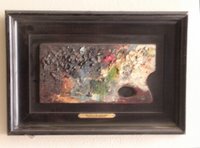June 1896: The Inland Printer
Recently Frank Hensley, one of our oldest members, gave me some photocopies of articles he had found about the Palette and Chisel. One of the articles is from The Inland Printer, dated June 1896--a year after the club was formed. The short article, coming so close on the heels of the founding of the club, is important to the history of the P&C.
Here it is:
Here it is:
An association of artists and craftsmen for the purpose of work and study--such is the Palette and Chisel Club of Chicago, some of the members of which appear in the half-tone upon the opposite page, engraved from a photograph by Carl Mauch. The organization is unique in that its members are all wage-workers and busy during the week with pencil, brush or chisel, doing work to please other people. But on Sunday mornings, at 9 o'clock, they assemble in the studio of Lorado Taft, in the Athenaeum Building, and for five hours each amuses himself by working in his chosen medium, to suit himself.
Sunday morning means a good deal to one who has worked all week, and the thought of these young men placing their easels and arranging their palettes at an hour when the rest of the city is in bed or on bicycles, is sufficient proof of their earnestness. A peep into the studio would show the men at work using all kinds of mediums, oil and water color, wash, pen and ink, charcoal, clay and modeling wax, and each as busy as a boy with a jackknife. And the conversation while the model rests deals not so much with "impressionism" and "realism," or the tendency and mode of artistic revelation as with the best methods of drawing for reproduction or the discussion of technicalities in the sculptor's or decorator's arts.
The work of the club has so far been more for study than exhibition, but there can be no doubt that such a movement among men actually engaged in illustration and decoration and kindred arts appealing directly to the people must result in improving the standard of their work. The impression that a "real artist" is incapable of doing work "for the trade" is less erroneous than the idea that an atist earning his living by practical application of his talents may not be an artist worthy of the name. The painter may lack the technical training necessary to the successful illustrator, but an experience in designing or illustration often develops qualities in a man who is prevented from attempting the higher branches of art by lack of time or opportunity, which when his chance comes, gives him an advantage over the mere painter.
Two-thirds of the members are students in the "life class" at the Art Institute night school, and a desire for opportunity to study from the model in daylight, so that color might be used, led to the organization of the club. The time at their disposal is too short to spend in bothering with officers or by-laws, so the only formality is the payment of the monthly dues to the treasurer, Curtis Gandy, who settles the rent and pays the models.
The following is a list of the club's membership: Charles J. Mulligan, David Hunter and W. J. Hutchinson, sculptors; Ray Brown, chief of the Times-Herald art department, and F. Holme, of the Evening-Post; Henry Hutt, illustrator and designer for J. Manz & Co.; Carl Mauch, of the Werner Company's art staff; Will Carqueville, poster designer and lithographer; Curtis Gandy, Capel Rowley, Richard Boehm, Edward Loewenheim and C.C. Senf, designers and illustrators; L. Pearson, F.J. Thwing and H.L. Bredtschneider, fresco painters and decorators; Fred Mulhaupt, display advertiser; Ancel Cook, scenic artist; A. Sterba and W.H. Irvine, portrait artists; Arthur Carr, H. Wagner, L.M. Coakley and J.S. Shippen, art students. Fred Larson is a "proofer," and the printer's trade is represented by W.A. Randall.
The treasurer's report shows a comfortable balance of cash in hand, and, while on Sunday meetings will soon be temporarily discontinued on account of the hot weather, the dues will run on just the same, so that when the club assembles in the fall it will be with every promise of a good and successful career.


1 Comments:
I don't know what other documents discuss the founders, but this one certainly addresses an issue that was raised in a by-laws meeting several months ago -- and is bound to re-surface again in the future.
Were the founders of the P&C the cutting-edge, avant-garde, modernist rebels of their day ?
This document makes a definate point of saying "NO" :
"the conversation while the model rests deals not so much with "impressionism" and "realism," or the tendency and mode of artistic revelation as with the best methods of drawing for reproduction or the discussion of technicalities in the sculptor's or decorator's arts."
We still have a few -- though not many -- such tradesmen left at the P&C -- but the following situation has pretty much stayed the same:
"The time at their disposal is too short to spend in bothering with officers or by-laws, so the only formality is the payment of the monthly dues to the treasurer"
(well... we do have officers and bylaws now ... but no one still has much time for projects other than their own)
The last thing I'd like to note is the reference to Fred Larson -- the founding member who was a "proofer" (is that a proof-reader ??) Fred Larson later went on to become treasurer -- and while serving in that capacity, he mortaged his family home to enable the P&C to purchase 1012 S. Dearborn.
If the P&C as we know it has a founding father --- he's it.
Post a Comment
<< Home